Web Infantry Equipment, Pattern 1937
Water Bottle Carriers
Stores Ref. A1/AA 0576 Carrier, water-bottle, W.E. Patt. ‘37
Stores Ref. CN/AA 0576 Web Equipment, Patt. ’37, Carrier, water bottle
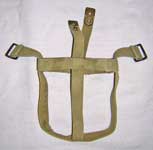
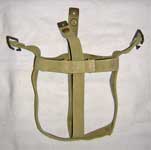 When first announced, this Carrier was of “framework”, or “skeleton” form, its design dating back to pre- Great War but, in the U.K., from Patt. ’19. As first produced, the securing strap was split into two, fastening on the shoulder of the bottle with a press-stud. In the early 1950s, a version appeared with a brass buckle, in place of the stud. This example is maker marked "B.H.G." (Barrow, Hepburn & Gale) and dated 1938. From the Karkee Web Collection.
When first announced, this Carrier was of “framework”, or “skeleton” form, its design dating back to pre- Great War but, in the U.K., from Patt. ’19. As first produced, the securing strap was split into two, fastening on the shoulder of the bottle with a press-stud. In the early 1950s, a version appeared with a brass buckle, in place of the stud. This example is maker marked "B.H.G." (Barrow, Hepburn & Gale) and dated 1938. From the Karkee Web Collection.
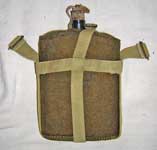
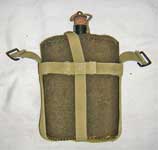 The same carrier, shown with a WWII era green enameled Mk. VI Water bottle.
The same carrier, shown with a WWII era green enameled Mk. VI Water bottle.
Stores Ref. A1/AA 5064 Carrier, water-bottle, bucket type, W.E. Patt. ‘37
Stores Ref. CN 0582 Web Equipment, Patt. ’37, Carrier, water bottle, bucket type
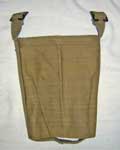
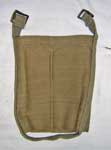 When the many extra companies became involved, a re-think occurred. What was then a “production engineering” exercise would today be called “lean manufacturing”. In place of the webbing framework, from 1940, the new “industry standard” reverted to a “bucket type” (so called by the Army. In reality, this was the type used in Patt. ’25. Early production by companies other than M.E.Co. and M.W. & S. utilised a narrower webbing stock, the sleeve leaving about one inch of the bottle protruding. After that, the full-length sleeve became standard. From 1943, these can be found with Sheradised buckles, but post-war production reverted to the framework type, using buckles that were Bonderised and with the securing strap changed to a top-fastening position. It spent the War as Not In Vocabulary, with its 5000 Series code. L. of C. §C4686 give it the above nomenclature, as an alternative Carrier and re-coded it in Section CN of the C.C.N. Having had a status of Not In Vocabulary (N.I.V.) during the War, it had had no official A1/AA identity, though a code had been allocated, so its post 1951 version was just “CN”. The example shown here is maker marked "Bagcraft" and dated 1942. From the Karkee Web Collection.
When the many extra companies became involved, a re-think occurred. What was then a “production engineering” exercise would today be called “lean manufacturing”. In place of the webbing framework, from 1940, the new “industry standard” reverted to a “bucket type” (so called by the Army. In reality, this was the type used in Patt. ’25. Early production by companies other than M.E.Co. and M.W. & S. utilised a narrower webbing stock, the sleeve leaving about one inch of the bottle protruding. After that, the full-length sleeve became standard. From 1943, these can be found with Sheradised buckles, but post-war production reverted to the framework type, using buckles that were Bonderised and with the securing strap changed to a top-fastening position. It spent the War as Not In Vocabulary, with its 5000 Series code. L. of C. §C4686 give it the above nomenclature, as an alternative Carrier and re-coded it in Section CN of the C.C.N. Having had a status of Not In Vocabulary (N.I.V.) during the War, it had had no official A1/AA identity, though a code had been allocated, so its post 1951 version was just “CN”. The example shown here is maker marked "Bagcraft" and dated 1942. From the Karkee Web Collection.
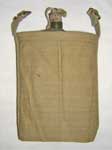
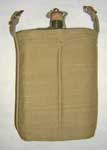 The same Water bottle carrier, shown with a WWII era green enameled Mk. VI Water bottle.
The same Water bottle carrier, shown with a WWII era green enameled Mk. VI Water bottle.
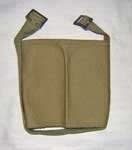
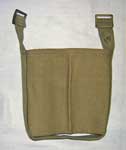 The early version of the bucket type Water bottle carrier, made from short web stock. This example is dated 1941 and maker marked "T.S. (O) Ltd.", for Thos. Sampson (Oldham) Ltd. From the Karkee Web Collection.
The early version of the bucket type Water bottle carrier, made from short web stock. This example is dated 1941 and maker marked "T.S. (O) Ltd.", for Thos. Sampson (Oldham) Ltd. From the Karkee Web Collection.
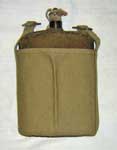
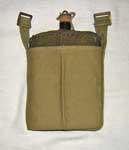 Once again, the same 1941 dated Carrier shown above, modelled with the same Water bottle used with the other two examples. You can see how much shorter this version of the Carrier actually is.
Once again, the same 1941 dated Carrier shown above, modelled with the same Water bottle used with the other two examples. You can see how much shorter this version of the Carrier actually is.